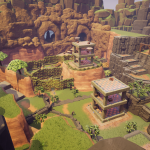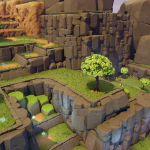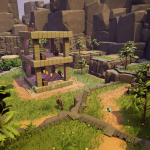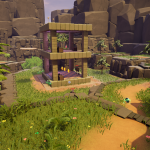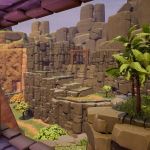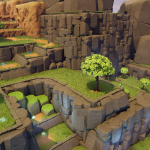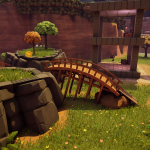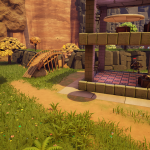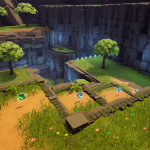
About the project

Homelands is a 3D platformer which I developed for my Final Year Project at Staffordshire University. The player takes control of Tempa an excitable adventurer who is looking to explore the world by herself, but it has been tainted by the evil skeleton crew. Players can experience what it’s like to have the ability to pull off awesome jumps, navigate around dangerous hazards, fight enemies and collect all the lost treasure of the homelands.
It is a level design project that was made to showcase and broaden my level design skills and was awesome to create because I got a taste of what a full development period would consist of. The main goal of this project was to create a stylized platformer that offered a fresh look on this genre all while keeping true to its iconic traits.
This chapter introduces the player is introduced to Tempa's movement systems, attacking and abilities. Plunge enough treasure and you will be allowed to leave
Level design workflow
Part 1 metrics
The most important part of any platformer is ensuring that the character has a fun and fair movement system. To achieve that I had to competently understand what her capabilities are. I looked at all aspects including height, distance, types and jump cycle. I measured these metrics by creating a fun filled wonderful land of all different shapes and sizes in ue4, where I would also test new mechanics, enemies, FX and all of that good stuff.
Tempa Distances in UU (Unreal units) = 1cm
Standing
Moving single jump – 400
Double jump – 740
Jump dash – 650
Jump dash jump – 1045
Running jump
Single Jump – 595
Jump air dash – 1100 -1200 (the variation depends on whether the player lets Tempa hover after the jump or just presses)
Double Jump -1160
Jump dash jump – 1800 best
These key metrics gave me the understanding and freedom to then design thoughtful, challenging and memorable play experiences.



Reason for her jumps and rolls movement
Initially, her movement was slower, but the jumps provided her with more distance in the air and forward. This system was tweaked to add the air dash into her jump combo, this creates a wider variety of jumps for me to not only test my player on but to add variation to the gameplay. The combo is jump-dash jump – I would have liked her to jump, jump dash, but the double jump being a front flip removed believability from the animations. Her movement is quicker, and it allows the player to toggle sprint on and off giving her a moderate speed boost.
She also has rolls which are extremely helpful for dodging traps and enemy attacks, it can also provide some distance between her and an enemy. The dodges initially were made like that of dark souls where whatever direction you are moving you press roll and it will move that way. This system felt too clunky and some of the rolls would never be used as I didn’t have the gameplay to facilitate it or better yet it isn’t fun to use.
The movement system was designed to replicate that of Ratchet and Clank and Spyro as these are tried and tested platformers. Additionally, with my limited animation skill and assets available, this was the best outcome to prioritise fun gameplay and a believable character.
Part 2 world and mechanic inspiration

Visual Inspiration
Homelands Chapter 1 takes heavy influence visually from the Spyro reignited trilogy as it offers beautiful grassy/rocky/fields. Spyro really nailed that squishy world feel but challenging combat synergy which I aimed for. The choice of bright colours and the stylised world was a reflection of my mechanics, there aren’t any stealth and really high-intensity platforming sections so there was no need for a dark and gritty world. As it’s the first level I want to welcome the player and encourage them to explore and be daring as well as let them freely get used to the character, the art style reinforces that narrative.
I want the player to feel peaceful and harmonic because of the bright but eye-pleasing colours used on the landscape as well as the meshes.
Mystery and intrigue: When the player enters the cave section of the level, they will find themselves surrounded by lava. This section will force the player underground to navigate around moving platforms.
Accomplishment: There is a variety of coins for the player to collect that will unlock the door to the next area when the coin amount is reached


Gameplay inspiration
This is the first level of the game and teaches the player the main jump mechanics such as jump, double jump, and jump dash jump. This includes the heights and lengths of these jumps both standing and at running character speeds. I want the player to feel competent with the movement by the end of the level. The gameplay will be simple using only one element at one time for most of the level. Platforms will be the mastery environmental mechanic for this level.
Using Nintendo’s formula, I will introduce the platforms in a safe way, test them in an unsafe way, twist the formula on its head and throw it away. As well as platforming there will be enemies which will teach players about rolling, health and combat in the game.


Part 3 designing the level

Blockouts
Now that I have my theme and metrics I can start to design the levels themselves. I drew a couple of iterations on paper first to get a feel of the shapes, map size and length I was going for. I designed the blockouts using 3DS Max as it gave me a quick way to prototype iterations and export them into ue4 at the correct scale. It helped me to understand the spacing between the obstacles, height and travel distance which all tied into my level flow.
These first blockouts were used to mainly get feedback on the types of jumps and difficulties my players felt should be in a first level. The feedback was that the player should start in a flat area and be challenged with easier jumps. I tried to be innovative with the starting area and not just have a cushy easy start. I was wrong to do this, especially with a small project like this; in this case, it wasn’t better to reinvent the wheel. From here I knew I needed to look at my jumps and the starting area to make it more suitable for my players.


Second draft
I listened to my feedback and made the player start in a flat area – as you can see in the sections that have no floor I am planning on getting a cloud asset that will give the feeling of it floating in the skies. I am starting to flesh out my climbing by having jumps that require backtracking. The tower for example requires you to go underneath and then forward to some platforms which give you enough elevation to get on top.
My feedback was that I am mixing too many elements into one this made me remember how Nintendo introduce and throw away mechanics in their levels. I wanted to use this level as an introduction to the movement, but it feels confusing and a tutorial section is needed to explain the jumping especially. I completely got lost in trying to create something cool I forgot that the player needs to feel confident with the basics before the more challenging mechanics can follow.
Third Draft
Add annotations to the pictures for the sections you wish to explain.

This was a big change to the level overall as I added two new sections. The first part was added as I found out very quickly from the last playtest my players felt confused about what to do and how they should be using the jumps (jump combos) so I added a whole section which first introduces the jumps in a structured way. This goes from Single jump to double to jump air dash then finally jump dash jump. I test them on the heights and lengths of the jumps before they drop to the level where they would meet combat and hazards.


The next part of the level is the round platform area. This came from reflection after my last lot of playtesting which made me think about how Nintendo approaches to level design. So, I have dedicated the whole first section to using platforms, moving, stationary and vertical all of them will be used to test the players’ knowledge of the jumping mechanics. This new section retracts platforms into walls forcing the player to time jumps and master them as there is now a natural hazard of falling and dying involved. This section also adds a nice change of pace as it would be inside away from the pretty soft greenery and immediately add a sense of urgency and threat to the player. From this point, I had sufficient feedback and knowledge to start creating my level’s final design.
Part 4 Final Design breakdown

At this point, my level took a massive leap from the last block out to this design. I had many University projects going on at this point and I made a decision to just make the final draft on paper and start meshing out the level. I wouldn’t have had time to do another block-out prototype and get playtest advice.
I am aware that in the industry this isn’t standard as it’s harder to iterate with meshing but I felt I had enough ideas and knowledge of what my players wanted and what I wanted to create. However, a wide variety of these areas were adapted from my blockouts and this final level is very similar to the drafts. So although I dove in head first I stuck to what I knew worked, and what people liked and that’s reflected in this design
Breakdown of design choices
The starting area
This area is almost identical to the one that I blocked out and follows the same layout and gameplay pace as before. This area gives the player a variety of jumps in height distance and type. I set the variables for the jumps up so the player would have to use that jump to progress, teaching them to use that jump. For example, they start off with a single jump and then have to use the double jump for the height it gives for them to progress.
I did not incorporate fall damage partly due to tech restrictions and also because it didn’t feel right and slowed down gameplay and pace.


I repeated this throughout the starting area with all the types of jumps so the player can feel comfortable with the types of jumps and practice them in a safe area. I made it possible for the player to fail jumps by having gaps between each one that the player can fall into which then forces them to retry that jump before they can progress.
Semiotic use
Here I used a yellow decal sprayed across certain jumps to symbolise that a full jump combo is needed (jump dash jump). This helps the player differentiate the jump they may need as there are a few combos to learn when you first start.
Main Area
The primary goal of this area was to improve upon the player’s understanding of Tempa’s jumps whilst also teaching them a few more mechanics. The game isn’t centred around combat but is added to keep the player engaged and improve the general flow. I used enemies sparingly as the combat isn’t what this project was designed to showcase but I still understood the importance of having them at my level.
I used lots of different moving platforms with all different speeds and sizes to cause challenges and prompt the player to think about what jump they should use. I love using changes in elevation as part of my designs and platformers are the best way to showcase this. I wanted the player to feel like the character has adapted her jumping to be the best at traversing the natural world. So the world needed to look like it’s just naturally filled with these crazy up and down areas.
Leading lines
This area is big so I used path textures to outline the general direction a player should be heading, I used convex shapes to also guide and assist the player, such as the bridge and cave entrance. The level takes a natural curve around also so they can follow the path and outside wall and reach their destination.


Final area
This area is the pinnacle of all the mechanics that the player has learned and now it’s time for them to put all that practice to good use. They will be punished for not making a jump by falling to their death but will respawn at a checkpoint. The player will have the added stress of timing jumps but at this point should be familiar with the different types, it’s a fair challenge. The platforms retract in and out with a few safe spaces to bring out that sense of urgency and an epic feel.
I wanted the player to feel mystery, intrigue and challenge. The lighting and colours used here are to reflect the sense of urgency and danger, I also switched to squared platforms as the sharp edges reinforce this feeling. This area is the twist to the mechanic they have learned.


As the main objective of the level is to collect enough coin to proceed to the next level/complete this level. I have outlined the main route in which a player would take to get all the coin as quickly as possible. Black line is for backtracking to the end door after coin amount has been reached which triggers a cutscene. The critical path takes the player past all the towers and into the cave.

Platforming Breakdown
(From top to bottom of the Key)
- The first section of the level will introduce the player to the very basics of movement and will aid them by having text pop-ups appear. These text pop-ups got added because playtesting told me that the jumps weren’t clear, and controls weren’t properly introduced. This area has additional coins and chests that will test jumping knowledge to get to it.
- The jumping distances are shown and this important because the length that you can get from full jump combo is quite long. So long that most players in testing thought they would never make a certain jump. So, they are introduced to the yellow pain affordance which means the full jump combo is needed. The player can’t fall and die here and if they do, they will need to climb back up. Here is where the player will encounter their first platform in a safe way (falling means no death).
- This section tests the players ability to use the jumps quickly and to use the correct ones. Climbing the moving stairs to get to the top. Then it is flipped, and the player will have to move along and time their jumps on the vertical movers. This breaks up the gameplay nicely before the next combat heavy section.
- There is two platforms that move vertically around the tower, the player must jump on this to get to the top. It also gives the player a chance to have a look around the level and see the path forward.
- This section relies on the player knowledge from climbing the tower. Once up the tower there is a series of platforms ahead. By using their knowledge of jump distances, the player can navigate onto the last tower and move over into the cave section. This tests the moving platform mechanic whilst staying relatively easy.
- This is the real test and the twist of the moving platform mechanic. The first part is filled with platforms moving in near unison to create a flat path over the lava. Here there is no real danger caused by the platforms. Then comes the platforms that retract into the wall and forces the player to move quickly or face certain death. This is the final test of the moving platforms and is fitting as it’s the most difficult with the lava adding to the sense of fear.

Flow and pace
- Start of the level basic introduction to the mechanics. The area looks cool and provides some exploration and learning about coin count
- Introduction to the lengths at which Tempa can jump, a narrow area not offering much in the way of scenery. Also, learn about moving platforms
- The first enemy is shown, and the player engages in a battle, afterwards learning about health and picking it up.
- The player sees the main part of the level sees the towers around the map and can start to plan their route around the level. Here is the first focal point.
- Moving around the level, the flattest part of the level offers some coins and combat but is no-platforming.
- Start to climb up the horizontal movers which test platforming knowledge as well as the speed of jumps
- Then come the jumps and combat which takes the player to the vertical movers which look cool but don’t provide any challenge on the platforming
- This section is a break from the hectic platforming, and has a few trivial jumps that end with the player being on top of the tower and able to get a clear view of the level whilst fighting enemies
- The climb around the temple to the tower provides some combat and a slight test of platforming
- The platforming over to the cave from the tower is challenging and players must use the correct jump to effectively complete this section. The focal point of the cave is also here.
- Players fall unexpectedly into the cave. Into a fiery dangerous area which is the final test of players platforming and moving platform knowledge. This is a fresh feel from the safe feeling theme of the main level.
- The hardest test of navigating around retracting platforms will leave the player left for dead in the lava if haste isn’t used. It’s the most challenging section.
- Most likely here is where the player will get a cutscene that shows the end of the level door is open.
- Players backtrack to the end of the level from wherever they reached the max coin amount. This will be a high decline as it will be going through previously explored areas.

My roles and responsibilities
- Designing the core movement and mechanics for Tempa
- Creating the traps/hazards and their behaviours
- Designing and creating the pickups within the level
- Blocking out levels in 3DS max for playtesting in UE4
- Using block outs as a planning tool for enemy, pickup and trap placement all while thinking about player flow and pace of the level
- Critically thinking about level flow, pace and the players experience
- Using affordances and semiotics to assist the player
- Designing and implementing low level enemy AI
- Reflecting on how I can use clichés and real world symbols or structure to assist players
- Documenting my progress on official Staffordshire University Forum
- Constant iteration on the levels to achieve the best final product
- Conducting playtesting sessions to refine and improve gameplay
- Creating complex levels using the Terrain tool
- Basic sound that’s implemented in level
- Basic UI design and implementation
- Basic principles of animation in Unreal Engine 4 such as rigging, retargeting and creating state machines on the animation graph
